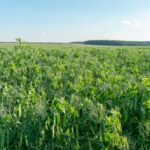Weed control is one of the most significant challenges faced by farmers across the world, and South Africa is no exception. Weeds compete with crops for essential resources like water, sunlight, and nutrients, which can lead to lower yields and increased costs. Fortunately, modern technology has introduced more efficient and sustainable methods for managing weeds. This article explores some of the most effective weed control strategies using modern equipment that can enhance productivity on South African farms.
1. Pre-Emergence Herbicides
One of the most widely used methods for controlling weeds is through the application of pre-emergence herbicides. These chemicals are applied to the soil before weeds germinate, creating a barrier that inhibits seedling growth. South African farmers often use pre-emergence herbicides to manage a variety of broadleaf weeds and grasses, ensuring crops have a better chance of establishment.
Modern sprayers, such as boom sprayers and self-propelled sprayers, make applying these herbicides more efficient. These sprayers can cover large areas quickly, while also being able to precisely control the amount of herbicide used. This precision reduces waste and minimizes environmental impact, making them ideal for large-scale farming operations.
2. Post-Emergence Herbicides
For weeds that have already emerged and are actively growing, post-emergence herbicides are an effective solution. These herbicides target established weeds while sparing crops. With the use of modern spraying technology, farmers can apply these herbicides with greater accuracy, reducing the risk of crop damage.
One of the most advanced systems for applying post-emergence herbicides is GPS-guided sprayers. These sprayers use satellite navigation to ensure that herbicides are applied only where needed, preventing overlap and ensuring optimal application rates. This technology helps South African farmers achieve better weed control while minimizing the risk of herbicide resistance and crop damage.
3. Integrated Weed Management (IWM)
Integrated Weed Management (IWM) is a holistic approach to controlling weeds using a combination of physical, chemical, and biological methods. Modern equipment can play a key role in this strategy by increasing efficiency and reducing reliance on chemical herbicides.
Some common techniques within IWM include:
- Crop Rotation: By rotating different crops each season, farmers can reduce weed pressure, as some weeds are more specific to certain crops. This method can be supported by modern tractors equipped with GPS to track planting patterns and optimize crop rotation schedules.
- Mechanical Weed Control: In addition to chemical methods, mechanical weeding is an effective tool in IWM. Weed harrows and inter-row cultivators are pieces of equipment that allow farmers to physically uproot weeds between rows of crops. These tools are particularly effective for small-scale farmers or organic farming operations where herbicide use is limited.
4. Robotic Weeders and Autonomous Machines
In recent years, robotic weeders and autonomous machines have revolutionized the way weeds are controlled on South African farms. These high-tech devices use advanced sensors and artificial intelligence (AI) to identify and remove weeds in real time. By distinguishing between crops and weeds, robotic weeders apply targeted mechanical or chemical treatment only where needed, significantly reducing herbicide use and improving sustainability.
For example, the ecoRobotix weeder is a solar-powered robotic weeder that uses precision spraying technology to selectively target weeds. It can operate autonomously, making it a time-saving and labor-efficient tool. The introduction of such equipment allows farmers to reduce labor costs and improve efficiency while minimizing their environmental footprint.
5. Cover Crops and Mulching
While not a form of mechanical equipment, cover crops and mulching are modern, sustainable techniques that can be effectively managed using modern equipment.
- Cover Crops: Planting cover crops like legumes and grasses between the main crop cycle helps suppress weed growth by outcompeting weeds for space and nutrients. Modern planters and seeders can efficiently sow cover crops across large areas, ensuring proper coverage and establishment.
- Mulching: Mulching involves placing organic or synthetic materials around plants to prevent weeds from sprouting. Modern mulching machines can efficiently spread mulch evenly across fields, providing excellent weed suppression while improving soil health.
6. Thermal Weed Control
Thermal weed control is a non-chemical method that uses heat to kill weeds. This technique is gaining popularity in South Africa as an alternative to herbicides, especially in environmentally sensitive areas. Modern equipment, such as flame weeders and hot-water weeders, can be used to apply heat directly to the weeds, causing them to wilt and die without harming the surrounding crops.
These devices work by using burners or pressurized hot water to target the weeds, and can be controlled with precision to avoid unnecessary damage to crops. Flame weeders are often used in fields with smaller weeds or in between rows of crops where mechanical weeding may be too invasive.
7. Drone Technology for Weed Monitoring
Drones are becoming increasingly popular for monitoring crop health and identifying weed infestations. Equipped with high-resolution cameras and sensors, drones can fly over farm fields and capture detailed images to detect early signs of weed growth. Farmers can then use this information to make informed decisions about where and when to apply herbicides or use mechanical methods.
Drones can also be used in combination with weed mapping software to create precise maps of weed distribution across large areas. This allows farmers to apply weed control measures only where needed, improving the efficiency and cost-effectiveness of the process.
8. Smart Spraying Systems
Smart spraying systems are advanced technologies that integrate GPS, sensors, and real-time data to apply herbicides only where they are needed. These systems reduce the overall volume of chemicals used, minimizing costs and environmental impact.
For example, precision spraying systems can detect the presence of weeds by analyzing the color and size of plants. The system then adjusts the spray nozzles to apply herbicide only on the weeds, reducing chemical waste and crop damage.
Effective weed control is vital for maintaining healthy crops and ensuring maximum yields in South Africa’s diverse farming environments. By leveraging modern equipment, such as precision sprayers, robotic weeders, thermal control systems, and drone technology, farmers can not only improve their weed control strategies but also contribute to a more sustainable farming future. Integrating these technologies into daily operations helps farmers reduce chemical usage, lower costs, and increase productivity, ultimately ensuring better profitability and environmental stewardship in the long term.
Join 'Farmers Mag' WhatsApp Channel
Get the latest Farming news and tips delivered straight to your WhatsApp
CLICK HERE TO JOIN






